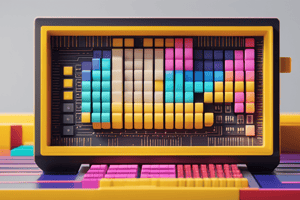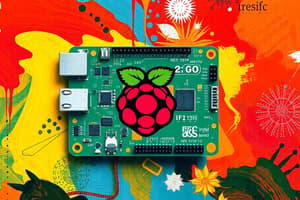Podcast
Questions and Answers
What is the primary purpose of a resistor in an electronic circuit?
What is the primary purpose of a resistor in an electronic circuit?
- To regulate the flow of electric current (correct)
- To amplify the electric signal
- To convert AC to DC power
- To increase the voltage level
What is the main function of a sensor in an electronic circuit?
What is the main function of a sensor in an electronic circuit?
- To amplify weak electrical signals
- To detect and respond to changes in the environment (correct)
- To convert electrical energy to mechanical energy
- To provide a stable voltage source
What is the purpose of the GPIO pins on a Picoboard?
What is the purpose of the GPIO pins on a Picoboard?
- To upload code to the microcontroller
- To connect to external devices and sensors (correct)
- To connect to a power source
- To debug the microcontroller
What is the unit of measurement for frequency in an electronic circuit?
What is the unit of measurement for frequency in an electronic circuit?
What is the purpose of the USB connector on a Picoboard?
What is the purpose of the USB connector on a Picoboard?
Flashcards are hidden until you start studying
Study Notes
Electronic Components
- Picoboard: a microcontroller-based development board used for physical computing
- Breadboard: a platform for prototyping electronic circuits, consisting of rows and columns of interconnected sockets
- Jumper Wires: used to connect components on a breadboard
- LED (Light Emitting Diode): a component that emits light when an electric current passes through it
- Resistor: a component that reduces the voltage or current in a circuit
- Sensor: a component that detects and responds to environmental changes, such as light, sound, or motion
- Motor Driver: a component that regulates the speed and direction of a motor
- Power Supply: a component that provides electricity to a circuit
- Buttons: components that allow users to interact with a circuit
- Buzzers: components that produce sound when an electric current passes through them
Electricity and Frequency
- Electron Flow: the movement of electrons through a circuit, creating an electric current
- Voltage: the potential difference between two points in a circuit, measured in Volts (V)
- Typical Voltage Levels: 3.3V, 5V, 9V, 12V
- Frequency: the number of oscillations or cycles per second, measured in Hertz (Hz)
Picoboard Components
- GPIO Pins: General Purpose Input/Output pins that allow for input/output operations
- USB Connector: a connector that allows the Picoboard to connect to a computer
- CPU (Central Processing Unit): the brain of the Picoboard, executing instructions and performing calculations
- LED: a built-in light source used for debugging
- Debug Pins: pins used for debugging and troubleshooting
- GND Pins: Ground pins that provide a reference point for the circuit
- Power Pins: pins that provide power to the circuit
Microcontrollers
- Purposes: used in various applications, such as robotics, automation, and IoT devices
- Examples: Arduino, Raspberry Pi, Picoboard
Micropython
- Library Modules: pre-built code libraries that provide functionality for specific tasks
- Functions: reusable blocks of code that perform specific tasks
- Loops: used to repeat a sequence of instructions
- Variables: store and manipulate data
- Inputs and Outputs: used to interact with the user and external devices
Breadboard Arrangement
- Rows and Columns: interconnected sockets on a breadboard
- Rails: long rows of sockets on a breadboard, used for power and ground connections
- Bars: short rows of sockets on a breadboard, used for component connections
- Pin to Breadboard Numbers: used to identify the correct pin connections on a diagram
Studying That Suits You
Use AI to generate personalized quizzes and flashcards to suit your learning preferences.




